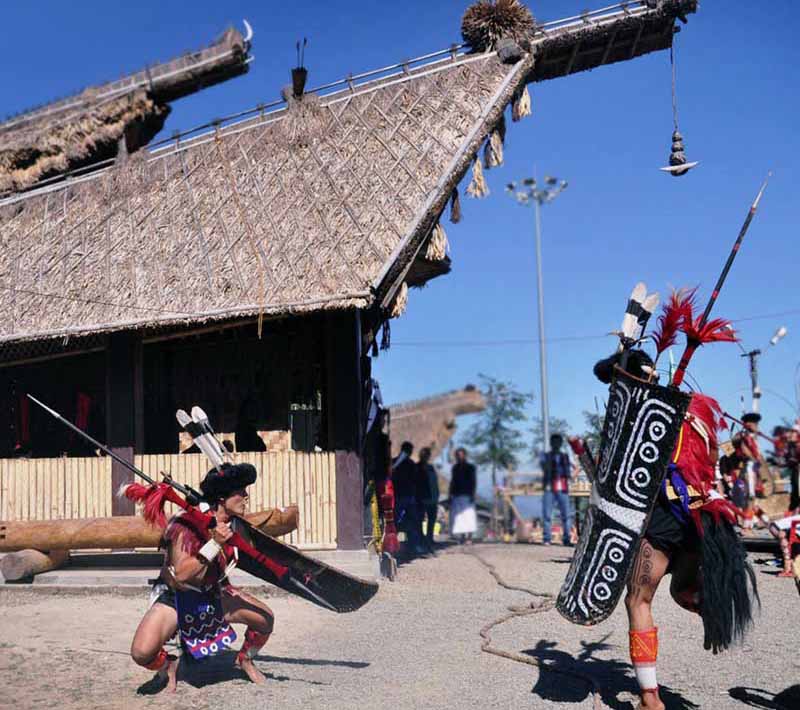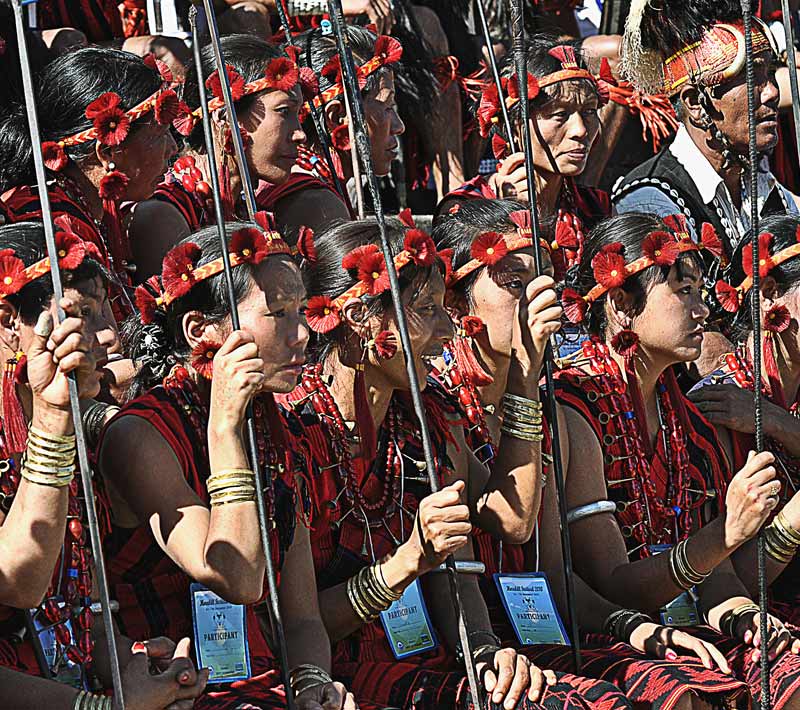
NAGALAND is a land of festivals. All the tribes celebrate their distinct seasonal festivals with a pageantry of colour and a feast of music.
Nagaland has a rich linguistic tradition with as many languages as there are tribes, each exclusive to itself.What is even more remarkable is that even within the language of a particular tribe, there are dialects mutually unintelligible. For instance, in some tribes like the Angami, every village has a slightly different variation even within the same dialect-this variance progressively increasing with the geographical distance. This makes inter-tribe and intra-tribe communication very difficult. In the circumstances, English has come to serve as the State language while Nagamese, a kind of pidgin Assamese, has become the common lingua.
| Tribes of Nagaland | |||
|---|---|---|---|
| 1. Angami | 2. Ao | 3. Chakhesang | 4. Chang |
| 5. Khiamniungan | 6. Kuki | 7. Konyak | 8. Kachari |
| 9. Lotha | 10. Phom | 11. Pochury | 12. Rengma |
| 13. Sumi | 14. Sangtam | 15. Tikhir | 16. Yimkhiung |
| 17. Zeliang | |||
All the tribes have their own festivals which they hold so dear. They regard their festivals sacrosanct and participation in celebration is compulsory. They celebrate their distinct seasonal festivals with a pageantry of colour and a feast of music.
Most of these festivals revolve round agriculture, it being the main-stay of Naga society. Over 85% population of Nagaland is directly dependent on agriculture and lives in a thousand and odd villages situated on high hill tops or slopes overlooking verdant valleys humming with murmuring streams. In this blissful setting Nagas enjoy the blessing of Nature with rare gusto striking the onlookers with awe and admiration. In most of the places agriculture consists of monocrop.
Although some religious and spiritual sentiments are inter woven into secular rites and rituals, the pre- dominant theme of the festivals is offering of prayers to a Supreme Being having different names in different Naga dialects. At these festivals, the spirit of Gods is propitiated with sacrifices by the Village Shaman for a bountiful harvest either before the sowing or on the eve of harvest.
The State is replete with festivities throughout the year, as all tribes celebrate their own festivals with a pageantry of colour, music and dance. A common feature is that the festivals revolve around agriculture, the mainstay of Naga economy. These festivals hark back to times prior to the advent of Christianity.

| Sl.No | Tribe | Festival | Month |
|---|---|---|---|
| 1. | Angami | Sekrenyi | 25 February |
| Terhünyi | 9 December | ||
| 2. | Ao | Moatsu | 2 May |
| Tsungremmong | 1-2 August | ||
| 3. | Chakhesang | Sökrönye | 15 January |
| Tsukhenie | 24 April | ||
| 4. | Chang | Poang Lüm | 13 January |
| Kundaglün | 1 April | ||
| Naknyulüm | 31 July | ||
| 5. | Khiamniungan | Khaozaosie - Hok - Ah | 20 January |
| Biam | 7 August | ||
| Tsokum | 5 October | ||
| 6. | Kuki | Mimkut | 17 January |
| Chavang Kut | 1 November | ||
| 7. | Konyak | Aoleang | 1- 2 April |
| Lao - Ong Mo | 28 September | ||
| 8. | Kachari | Bishu | 27 January |
| 9. | Lotha | Tokhu Emong | 6 - 7Novemebr |
| 10. | Phom | Monyu | 1 - 2 April |
| 11. | Pochury | Yemshe | 5 October |
| 12. | Rengma | Ngada | 27 - 28 November |
| 13. | Sumi | Tuluni | 8 July |
| Apikimti | 4 - 5 November | ||
| Ahuna | 14 - 15 November | ||
| 14. | Sangtam | Tsohsu | 12 March |
| Hunapongpi | 18 August | ||
| Mongmong | 3 September | ||
| 15. | Tikhir | Kuhlang - Nyi | 18 January |
| Tsonglak-Nyi | 9 October | ||
| 16. | Yimkhiung | Wangtsunuo | 16 April |
| Metemneo | 8 August | ||
| 17. | Zeliang | Mileinyi | 11 March |
| Langsimnyi | 31 October |
